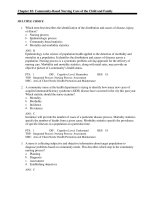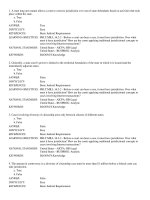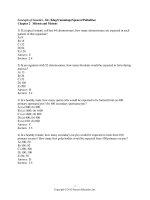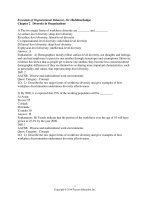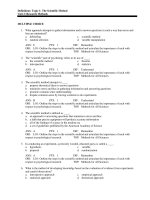Essentials of understanding psychology 10th edition feldman test bank
Bạn đang xem bản rút gọn của tài liệu. Xem và tải ngay bản đầy đủ của tài liệu tại đây (278.85 KB, 53 trang )
Chapter 02 - Neuroscience and Behavior
Chapter 02
Neuroscience and Behavior
Multiple Choice Questions
1. (p. 50) Psychologists who specialize in considering the ways in which the biological structures
and functions of the body affect behavior are known as _____.
A. genetic psychologists
B. biopsychologists
C. evolutionary psychologists
D. clinical neuropsychologists
APA Goal Outcome: 1.2, 10.2
Bloom's Taxonomy: Remember
Difficulty: Easy
Learning Outcome: 5-1
2. (p. 50) Alison has developed an interest in the ways in which the biological structures and
functions of the body affect behavior. She will most likely become a(n):
A. genetic psychologist.
B. behavioral neuroscientist.
C. evolutionary psychologist.
D. clinical neuropsychologist.
APA Goal Outcome: 1.2, 10.2
Bloom's Taxonomy: Apply
Difficulty: Medium
Learning Outcome: 5-1
2-1
Copyright © 2013 McGraw-Hill Education. All rights reserved. No reproduction or distribution without the prior written consent of
McGraw-Hill Education.
Chapter 02 - Neuroscience and Behavior
3. (p. 51) The basic elements of the nervous system are called:
A. axons.
B. glial cells.
C. neurons.
D. neurotransmitters.
APA Goal Outcome: 1.2
Bloom's Taxonomy: Remember
Difficulty: Easy
Learning Outcome: 5-2
4. (p. 51) As many as _____ neurons throughout the body are involved in the control of
behaviour.
A. 1 billion
B. 1 trillion
C. 5 million
D. 50 million
APA Goal Outcome: 1.2
Bloom's Taxonomy: Remember
Difficulty: Easy
Learning Outcome: 5-2
5. (p. 51) Neurons are physically held in place by _____.
A. axons
B. glial cells
C. dendrites
D. myelin cells
APA Goal Outcome: 1.2
Bloom's Taxonomy: Remember
Difficulty: Easy
Learning Outcome: 5-2
2-2
Copyright © 2013 McGraw-Hill Education. All rights reserved. No reproduction or distribution without the prior written consent of
McGraw-Hill Education.
Chapter 02 - Neuroscience and Behavior
6. (p. 51) Which of the following is NOT one of the functions of glial cells?
A. They nourish nerve cells.
B. They communicate messages within the nervous system.
C. They help repair damage that might occur to neurons.
D. They provide nourishment to neurons.
APA Goal Outcome: 1.2
Bloom's Taxonomy: Understand
Difficulty: Medium
Learning Outcome: 5-2
7. (p. 51) A cluster of fibers at one end of a neuron that receives messages from other neurons is
called:
A. axon.
B. terminal button.
C. glial fiber.
D. dendrite.
APA Goal Outcome: 1.2
Bloom's Taxonomy: Remember
Difficulty: Easy
Learning Outcome: 5-2
8. (p. 51) An axon is a(n):
A. neuron's cell body.
B. cluster of fibers at one end of a neuron.
C. support cell in the nervous system.
D. long, slim, tubelike structure extending from a neuron.
APA Goal Outcome: 1.2
Bloom's Taxonomy: Remember
Difficulty: Easy
Learning Outcome: 5-2
2-3
Copyright © 2013 McGraw-Hill Education. All rights reserved. No reproduction or distribution without the prior written consent of
McGraw-Hill Education.
Chapter 02 - Neuroscience and Behavior
9. (p. 51) Which of the following structures is especially important for carrying messages
received by the dendrites to other neurons?
A. Neurotransmitter
B. Synapse
C. Axon
D. Glial cell
APA Goal Outcome: 1.2
Bloom's Taxonomy: Remember
Difficulty: Medium
Learning Outcome: 5-2
10. (p. 51) Terminal buttons are found at the end of:
A. neurotransmitters.
B. dendrites.
C. axons.
D. glial cells.
APA Goal Outcome: 1.2
Bloom's Taxonomy: Remember
Difficulty: Easy
Learning Outcome: 5-2
11. (p. 51) Which of the following sequences correctly arranges nervous system structures from
the most general to the most specific?
A. Neuron axon terminal button
B. Neuron terminal button axon
C. Axon terminal button neuron
D. Axon neuron terminal button
APA Goal Outcome: 1.2
Bloom's Taxonomy: Understand
Difficulty: Medium
Learning Outcome: 5-2
2-4
Copyright © 2013 McGraw-Hill Education. All rights reserved. No reproduction or distribution without the prior written consent of
McGraw-Hill Education.
Chapter 02 - Neuroscience and Behavior
12. (p. 51) Dendrite is to axon what _____ is to _____.
A. receiving; sending
B. sending; receiving
C. reuptake; action potential
D. action potential; reuptake
APA Goal Outcome: 1.2
Bloom's Taxonomy: Understand
Difficulty: Easy
Learning Outcome: 5-2
13. (p. 52) Which of the following sequences accurately reflects the route followed by nerve
impulses when one neuron communicates with another?
A. Dendrite axon cell body
B. Dendrite cell body axon
C. Cell body axon dendrite
D. Axon dendrite cell body
APA Goal Outcome: 1.2
Bloom's Taxonomy: Understand
Difficulty: Medium
Learning Outcome: 5-2
14. (p. 52) Electrical wires are generally protected by a tube of plastic. A similar insulating
function is performed in the nervous system by the:
A. myelin sheath.
B. glial cells.
C. terminal buttons.
D. synapse.
APA Goal Outcome: 1.2
Bloom's Taxonomy: Understand
Difficulty: Medium
Learning Outcome: 5-2
2-5
Copyright © 2013 McGraw-Hill Education. All rights reserved. No reproduction or distribution without the prior written consent of
McGraw-Hill Education.
Chapter 02 - Neuroscience and Behavior
15. (p. 52) _____ is a protective coat of fat and protein that wraps around the axon.
A. Myelin sheath
B. Glial cell
C. Dendrite
D. Synapse
APA Goal Outcome: 1.2
Bloom's Taxonomy: Remember
Difficulty: Easy
Learning Outcome: 5-2
16. (p. 52) You cannot fire a gun softly, or flush a toilet halfway. Like an action potential, gun fire
and a toilet's flush follow the _____ law.
A. incremental transformation
B. graded action
C. all-or-none
D. intensity of stimulus
APA Goal Outcome: 1.2
Bloom's Taxonomy: Understand
Difficulty: Medium
Learning Outcome: 5-2
17. (p. 52) The rule that neurons are either on or off is known as the _____ law.
A. intensity of stimulus
B. graded action
C. all-or-none
D. incremental transformational
APA Goal Outcome: 1.2
Bloom's Taxonomy: Remember
Difficulty: Easy
Learning Outcome: 5-2
2-6
Copyright © 2013 McGraw-Hill Education. All rights reserved. No reproduction or distribution without the prior written consent of
McGraw-Hill Education.
Chapter 02 - Neuroscience and Behavior
18. (p. 52) The state in which there is a negative electrical charge of about -70 millivolts within a
neuron is known as the _____ state.
A. triggering
B. terminal
C. optimum
D. resting
APA Goal Outcome: 1.2
Bloom's Taxonomy: Remember
Difficulty: Easy
Learning Outcome: 5-2
19. (p. 53) Regarding action potentials, which of the following statements is TRUE?
A. As the impulse travels along the axon, the movement of ions causes a change in charge from
positive to neutral in successive sections of the axon.
B. The action potential moves from one end of the axon to the other like a flame moving along
a fuse.
C. After the impulse has passed through a particular section of the axon, negative ions are
pumped out of that section, and its charge returns to positive while the action potential
continues to move along the axon.
D. Just after an action potential has passed through a section of the axon, a neuron can fire again
immediately if it receives appropriate stimulation.
APA Goal Outcome: 1.2
Bloom's Taxonomy: Remember
Difficulty: Medium
Learning Outcome: 5-2
20. (p. 53) As an action potential occurs, the neuron's electrical charge:
A. changes from negative to neutral.
B. changes from positive to neutral.
C. changes from negative to positive.
D. changes from positive to negative.
APA Goal Outcome: 1.2
Bloom's Taxonomy: Remember
Difficulty: Medium
Learning Outcome: 5-2
2-7
Copyright © 2013 McGraw-Hill Education. All rights reserved. No reproduction or distribution without the prior written consent of
McGraw-Hill Education.
Chapter 02 - Neuroscience and Behavior
21. (p. 54) _____ are specialized neurons that fire not only when a person enacts a particular
behavior, but also when a person simply observes another individual carrying out the same
behavior.
A. Pharyngeal motorneuron
B. Mirror neurons
C. Ventral cord motor neuron
D. Amphid neurons
APA Goal Outcome: 1.2
Bloom's Taxonomy: Remember
Difficulty: Easy
Learning Outcome: 5-2
22. (p. 54) Regarding mirror neurons, which of the following statements is ACCURATE?
A. Mirror neurons are involved in face recognition and language acquisition, but not in
empathy.
B. Mirror neurons are involved in empathy and face recognition, but not in language acquisition.
C. Mirror neurons are involved in empathy, language acquisition, and face recognition.
D. Mirror neurons are involved in empathy and language acquisition, but not in face
recognition.
APA Goal Outcome: 1.2
Bloom's Taxonomy: Understand
Difficulty: Medium
Learning Outcome: 5-2
23. (p. 55) A synapse is a(n):
A. chemical.
B. signal.
C. joint.
D. gap.
APA Goal Outcome: 1.2, 4.2
Bloom's Taxonomy: Understand
Difficulty: Medium
Learning Outcome: 5-2
2-8
Copyright © 2013 McGraw-Hill Education. All rights reserved. No reproduction or distribution without the prior written consent of
McGraw-Hill Education.
Chapter 02 - Neuroscience and Behavior
24. (p. 55) _____ is the space between two neurons where the axon of a sending neuron
communicates with the dendrites of a receiving neuron by using chemical messages.
A. Synapse
B. Terminal button
C. Axon
D. Cell body
APA Goal Outcome: 1.2, 4.2
Bloom's Taxonomy: Remember
Difficulty: Medium
Learning Outcome: 5-2
25. (p. 56) Which of the following statements regarding inhibitory messages is TRUE?
A. Inhibitory messages always increase the likelihood that a receiving neuron will fire.
B. Inhibitory messages decrease the likelihood that a receiving neuron will fire.
C. The dendrites of a neuron cannot receive both excitatory and inhibitory messages
simultaneously.
D. Inhibitory messages make it more likely that an action potential will travel down its axon.
APA Goal Outcome: 1.2, 4.2
Bloom's Taxonomy: Understand
Difficulty: Medium
Learning Outcome: 5-3
26. (p. 56) The reabsorption of neurotransmitters by a terminal button is termed as:
A. recycling.
B. reassertion.
C. reuptake.
D. reuse.
APA Goal Outcome: 1.2, 4.2
Bloom's Taxonomy: Remember
Difficulty: Easy
Learning Outcome: 5-3
2-9
Copyright © 2013 McGraw-Hill Education. All rights reserved. No reproduction or distribution without the prior written consent of
McGraw-Hill Education.
Chapter 02 - Neuroscience and Behavior
27. (p. 57) Which neurotransmitter is described INCORRECTLY?
A. Acetylcholine—transmits messages related to skeletal muscles
B. GABA—an excitatory neurotransmitter inhibited by alcohol or tranquilizers
C. Serotonin—helps regulate sleep and mood
D. Glutamate—plays a role in memory
APA Goal Outcome: 1.2
Bloom's Taxonomy: Understand
Difficulty: Medium
Learning Outcome: 5-3
28. (p. 58) The neurotransmitter dopamine is involved in:
A. the brain's effort to deal with pain.
B. Alzheimer's disease.
C. the regulation of sleep, eating, mood, and pain.
D. movement, attention, and learning.
APA Goal Outcome: 1.2, 4.2
Bloom's Taxonomy: Understand
Difficulty: Medium
Learning Outcome: 5-3
29. (p. 58) Which neurotransmitter is CORRECTLY matched with a psychological function?
A. Relief of pain—glutamate
B. Regulates mood—acetylcholine
C. Facilitates learning—dopamine
D. Contributes to memory—serotonin
APA Goal Outcome: 1.2
Bloom's Taxonomy: Remember
Difficulty: Medium
Learning Outcome: 5-3
2-10
Copyright © 2013 McGraw-Hill Education. All rights reserved. No reproduction or distribution without the prior written consent of
McGraw-Hill Education.
Chapter 02 - Neuroscience and Behavior
30. (p. 58) Which disorder is CORRECTLY paired with an associated neurotransmitter?
A. Parkinson's disease: dopamine
B. Depression: glutamate
C. Schizophrenia: serotonin
D. Alzheimer's disease: endorphins
APA Goal Outcome: 1.2, 4.2
Bloom's Taxonomy: Remember
Difficulty: Medium
Learning Outcome: 5-3
31. (p. 57) Inhibitory is to excitatory what _____ is to _____.
A. glutamate; GABA
B. glutamate; acetylcholine
C. GABA; glutamate
D. endorphins; GABA
APA Goal Outcome: 1.2
Bloom's Taxonomy: Understand
Difficulty: Medium
Learning Outcome: 5-3
32. (p. 60) Which expression below most closely approximates the number of neural connections
in the brain?
A. 10 quadrillion
B. 1 million
C. 1 billion
D. 1 trillion
APA Goal Outcome: 1.2, 7.3
Bloom's Taxonomy: Remember
Difficulty: Medium
Learning Outcome: 6-1
2-11
Copyright © 2013 McGraw-Hill Education. All rights reserved. No reproduction or distribution without the prior written consent of
McGraw-Hill Education.
Chapter 02 - Neuroscience and Behavior
33. (p. 60) The nervous system is divided into the _____ and the _____ nervous systems.
A. primary; secondary
B. somatic; autonomic
C. sympathetic; parasympathetic
D. central; peripheral
APA Goal Outcome: 1.2
Bloom's Taxonomy: Remember
Difficulty: Easy
Learning Outcome: 6-1
34. (p. 60) The brain and the spinal cord constitute the _____ nervous system.
A. central
B. peripheral
C. extraneous
D. parasympathetic
APA Goal Outcome: 1.2
Bloom's Taxonomy: Remember
Difficulty: Easy
Learning Outcome: 6-1
35. (p. 60) _____ is an automatic, involuntary response to an incoming stimulus.
A. Action potential
B. Intuition
C. Instinct
D. Reflex
APA Goal Outcome: 1.2
Bloom's Taxonomy: Remember
Difficulty: Easy
Learning Outcome: 6-1
2-12
Copyright © 2013 McGraw-Hill Education. All rights reserved. No reproduction or distribution without the prior written consent of
McGraw-Hill Education.
Chapter 02 - Neuroscience and Behavior
36. (p. 60) The _____ is the main means for transmitting messages between the brain and the
body.
A. cortex
B. medulla
C. axon
D. spinal cord
APA Goal Outcome: 1.2
Bloom's Taxonomy: Understand
Difficulty: Difficult
Learning Outcome: 6-1
37. (p. 60) Which of the following is TRUE of the spinal cord's control of behavior?
A. The spinal cord cannot control any behaviors without the help of the brain.
B. The spinal cord is not involved in reflexes.
C. The spinal cord can control some simple reflexes without the brain's help.
D. The spinal cord can control relatively complex behavior without the brain's help.
APA Goal Outcome: 1.2
Bloom's Taxonomy: Understand
Difficulty: Medium
Learning Outcome: 6-1
38. (p. 60, 61) The central nervous system is composed of _____. The peripheral nervous system
comprises _____.
A. the somatic and autonomic nervous systems; the sympathetic and parasympathetic nervous
systems
B. the somatic and autonomic nervous systems; the brain and the spinal cord
C. the sympathetic and parasympathetic nervous systems; the somatic and autonomic nervous
systems
D. the brain and the spinal cord; the somatic and autonomic nervous systems
APA Goal Outcome: 1.2
Bloom's Taxonomy: Understand
Difficulty: Medium
Learning Outcome: 6-1
2-13
Copyright © 2013 McGraw-Hill Education. All rights reserved. No reproduction or distribution without the prior written consent of
McGraw-Hill Education.
Chapter 02 - Neuroscience and Behavior
39. (p. 62) Sensory is to motor what _____ is to _____.
A. efferent; afferent
B. afferent; efferent
C. afferent; interneuron
D. interneuron; efferent
APA Goal Outcome: 1.2
Bloom's Taxonomy: Understand
Difficulty: Medium
Learning Outcome: 6-1
40. (p. 62) _____ are neurons that connect sensory and motor neurons, carrying messages
between the two.
A. Mirror neurons
B. Amphid neurons
C. Interneurons
D. Autoneurons
APA Goal Outcome: 1.2
Bloom's Taxonomy: Remember
Difficulty: Medium
Learning Outcome: 6-1
41. (p. 62) The two major divisions of the peripheral nervous system are the _____ and _____
divisions.
A. somatic; autonomic
B. sympathetic; parasympathetic
C. afferent; efferent
D. sensory; motor
APA Goal Outcome: 1.2
Bloom's Taxonomy: Remember
Difficulty: Medium
Learning Outcome: 6-1
2-14
Copyright © 2013 McGraw-Hill Education. All rights reserved. No reproduction or distribution without the prior written consent of
McGraw-Hill Education.
Chapter 02 - Neuroscience and Behavior
42. (p. 62) _____ is the part of the peripheral nervous system that specializes in the control of
voluntary movements and the communication of information to and from the sense organs.
A. Somatic division
B. Sympathetic division
C. Parasympathetic division
D. Autonomic division
APA Goal Outcome: 1.2
Bloom's Taxonomy: Remember
Difficulty: Easy
Learning Outcome: 6-1
43. (p. 62) Somatic is to autonomic what _____ is to _____.
A. involuntary; voluntary
B. voluntary; involuntary
C. excitation; rest
D. rest; excitation
APA Goal Outcome: 1.2
Bloom's Taxonomy: Understand
Difficulty: Medium
Learning Outcome: 6-1
44. (p. 62) The part of the autonomic division of the nervous system that acts to prepare the body
for action in stressful situations, engaging all the organism's resources to respond to a threat is
known as the _____.
A. somatic division
B. sympathetic division
C. parasympathetic division
D. apathetic division
APA Goal Outcome: 1.2
Bloom's Taxonomy: Remember
Difficulty: Easy
Learning Outcome: 6-1
2-15
Copyright © 2013 McGraw-Hill Education. All rights reserved. No reproduction or distribution without the prior written consent of
McGraw-Hill Education.
Chapter 02 - Neuroscience and Behavior
45. (p. 62) The "fight-or-flight" response is associated with the _____ division.
A. somatic
B. sympathetic
C. parasympathetic
D. apathetic
APA Goal Outcome: 1.2
Bloom's Taxonomy: Understand
Difficulty: Easy
Learning Outcome: 6-1
46. (p. 62) The part of the autonomic division of the nervous system that acts to calm the body
after an emergency has ended is known as the _____ division.
A. somatic
B. sympathetic
C. parasympathetic
D. apathetic
APA Goal Outcome: 1.2
Bloom's Taxonomy: Remember
Difficulty: Easy
Learning Outcome: 6-1
47. (p. 62) The _____ division also directs the body to store energy for use in emergencies.
A. somatic
B. sympathetic
C. parasympathetic
D. apathetic
APA Goal Outcome: 1.2
Bloom's Taxonomy: Understand
Difficulty: Easy
Learning Outcome: 6-1
2-16
Copyright © 2013 McGraw-Hill Education. All rights reserved. No reproduction or distribution without the prior written consent of
McGraw-Hill Education.
Chapter 02 - Neuroscience and Behavior
48. (p. 62) Which of the following situations is most likely to involve the action of the
parasympathetic nervous system?
A. Brooke's finger accidentally grazes the hot iron; she immediately jerks her hand away.
B. After mistaking her roommate for a thief, Callum relaxes with a glass of water.
C. Walking toward her car in a deserted parking lot one night, Danica is surprised by a strange
man appearing from nowhere.
D. Peyton is preparing to go to bed and is alarmed to see a stranger at her window.
APA Goal Outcome: 1.2, 4.4
Bloom's Taxonomy: Apply
Difficulty: Medium
Learning Outcome: 6-1
49. (p. 62) With respect to its potential basis in nervous system activity, "voodoo death" has been
attributed to:
A. an overactive sympathetic nervous system.
B. an overactive parasympathetic nervous system.
C. the cessation of sympathetic nervous system responses.
D. an understimulated central nervous system.
APA Goal Outcome: 1.2, 1.3, 3.1, 4.2
Bloom's Taxonomy: Remember
Difficulty: Easy
Learning Outcome: 6-1
50. (p. 62) Izzy sees a leopard in her backyard. Her pupils are dilated and her heart is pounding;
her breathing is shallow and rapid. Her _____ nervous system is active.
A. parasympathetic
B. sympathetic
C. apathetic
D. somatic
APA Goal Outcome: 1.2
Bloom's Taxonomy: Apply
Difficulty: Easy
Learning Outcome: 6-1
2-17
Copyright © 2013 McGraw-Hill Education. All rights reserved. No reproduction or distribution without the prior written consent of
McGraw-Hill Education.
Chapter 02 - Neuroscience and Behavior
51. (p. 63) Which of the following terms best describes the organization of the nervous system
today?
A. Linear
B. Recursive
C. Hierarchical
D. Random
APA Goal Outcome: 1.2
Bloom's Taxonomy: Understand
Difficulty: Medium
Learning Outcome: 6-1
52. (p. 63) The branch of psychology that seeks to identify behavior patterns that are a result of
our genetic inheritance from our ancestors is known as _____.
A. social psychology
B. health psychology
C. clinical psychology
D. evolutionary psychology
APA Goal Outcome: 1.2
Bloom's Taxonomy: Remember
Difficulty: Easy
Learning Outcome: 6-1
53. (p. 64) Evolutionary psychologists have spawned a new and increasingly influential field:
A. social psychology.
B. health psychology.
C. molecular genetics.
D. behavioral genetics.
APA Goal Outcome: 1.2
Bloom's Taxonomy: Remember
Difficulty: Easy
Learning Outcome: 6-1
2-18
Copyright © 2013 McGraw-Hill Education. All rights reserved. No reproduction or distribution without the prior written consent of
McGraw-Hill Education.
Chapter 02 - Neuroscience and Behavior
54. (p. 64) The study of the effects of heredity on how people conduct themselves is known as
_____.
A. behavioral genetics
B. classical genetics
C. development genetics
D. molecular genetics
APA Goal Outcome: 1.2, 10.2
Bloom's Taxonomy: Remember
Difficulty: Medium
Learning Outcome: 6-1
55. (p. 64) Dr. Schilling is investigating the potential genetic basis of antisocial personality
disorder by examining the relative prevalence of the disorder among either identical or fraternal
twins, raised either together or in different families. Dr. Schilling is best described as a _____.
A. behavioral geneticist
B. classical geneticist
C. development geneticist
D. molecular geneticist
APA Goal Outcome: 1.2, 4.2, 10.2
Bloom's Taxonomy: Apply
Difficulty: Medium
Learning Outcome: 6-1
56. (p. 64) Which of the following statements best expresses the relationship between the nervous
system and the endocrine system?
A. They operate entirely independently.
B. The endocrine system is part of the central nervous system.
C. The endocrine system influences and is influenced by the central nervous system.
D. The central nervous system is one part of the endocrine system.
APA Goal Outcome: 1.2
Bloom's Taxonomy: Remember
Difficulty: Easy
Learning Outcome: 6-2
2-19
Copyright © 2013 McGraw-Hill Education. All rights reserved. No reproduction or distribution without the prior written consent of
McGraw-Hill Education.
Chapter 02 - Neuroscience and Behavior
57. (p. 64) A key component of the endocrine system is the tiny _____ gland, which is found
near—and regulated by—the _____ in the brain.
A. adrenal; hippocampus
B. pituitary; hippocampus
C. adrenal; hypothalamus
D. pituitary; hypothalamus
APA Goal Outcome: 1.2
Bloom's Taxonomy: Understand
Difficulty: Medium
Learning Outcome: 6-2
58. (p. 64) The _____ gland is a major component of the endocrine system which secretes
hormones that control growth and other parts of the endocrine system.
A. esophageal
B. apocrine
C. parotid
D. pituitary
APA Goal Outcome: 1.2
Bloom's Taxonomy: Remember
Difficulty: Easy
Learning Outcome: 6-2
59. (p. 64) The _____ gland has sometimes been called the "master gland" because it controls the
functioning of the rest of the endocrine system.
A. pituitary
B. esophageal
C. apocrine
D. parotid
APA Goal Outcome: 1.2
Bloom's Taxonomy: Remember
Difficulty: Easy
Learning Outcome: 6-2
2-20
Copyright © 2013 McGraw-Hill Education. All rights reserved. No reproduction or distribution without the prior written consent of
McGraw-Hill Education.
Chapter 02 - Neuroscience and Behavior
60. (p. 64) The hormone oxytocin has been implicated in each of the following behaviors
EXCEPT the:
A. urge to nurse newborn infants.
B. desire to seek or respond to potential sexual partners.
C. development of trust in others.
D. tendency to produce violent, dangerous behavior.
APA Goal Outcome: 1.2
Bloom's Taxonomy: Remember
Difficulty: Easy
Learning Outcome: 6-2
61. (p. 65) Which of the following glands or structures is CORRECTLY matched with the
hormone it produces?
A. Pineal gland; oxytocin
B. Pancreas; insulin
C. Medulla; melatonin
D. Pituitary gland; aldosterone
APA Goal Outcome: 1.2
Bloom's Taxonomy: Remember
Difficulty: Medium
Learning Outcome: 6-2
62. (p. 65) Which of the following hormones is CORRECTLY matched with its function?
A. Aldosterone - regulates daily rhythms
B. Erythropoietin - regulates the sodium and potassium balance in the blood
C. Adipokines - regulate the production of red blood cells
D. Parathyroid hormone - increases blood calcium
APA Goal Outcome: 1.2
Bloom's Taxonomy: Remember
Difficulty: Medium
Learning Outcome: 6-2
2-21
Copyright © 2013 McGraw-Hill Education. All rights reserved. No reproduction or distribution without the prior written consent of
McGraw-Hill Education.
Chapter 02 - Neuroscience and Behavior
63. (p. 65) Which of the following statements is TRUE regarding hormone replacement therapy
as a treatment for menopausal symptoms?
A. It is used less frequently now than in the past.
B. It is the only treatment that does not have any side effects.
C. Its benefits outweigh its risks.
D. It has become increasingly popular.
APA Goal Outcome: 1.2, 4.4
Bloom's Taxonomy: Understand
Difficulty: Medium
Learning Outcome: 6-2
64. (p. 68) Which of the following is NOT a brain scanning technique?
A. Electroencephalogram (EEG)
B. Electromyogram (EMG)
C. Positron emission tomography (PET)
D. Transcranial magnetic stimulation (TMS)
APA Goal Outcome: 1.2, 2.2
Bloom's Taxonomy: Remember
Difficulty: Easy
Learning Outcome: 7-1
65. (p. 69) Which brain imaging technique below is CORRECTLY matched with its description?
A. EEG—records the brain's electrical activity with electrodes
B. PET—causes a momentary interruption of the brain's electrical activity
C. fMRI—traces biochemical activity in the brain
D. TMS—produces a graph of electrical wave patterns
APA Goal Outcome: 1.2, 2.2
Bloom's Taxonomy: Understand
Difficulty: Medium
Learning Outcome: 7-1
2-22
Copyright © 2013 McGraw-Hill Education. All rights reserved. No reproduction or distribution without the prior written consent of
McGraw-Hill Education.
Chapter 02 - Neuroscience and Behavior
66. (p. 69) Which brain imaging technique below is INCORRECTLY matched with its diagnostic
use?
A. EEG—facilitates the diagnosis of epilepsy and learning disorders
B. PET—may help identify brain tumors
C. fMRI—improves diagnosis of strokes and multiple sclerosis
D. TMS—facilitates the diagnosis of nervous system disorders such as Alzheimer's disease
APA Goal Outcome: 1.2, 4.2
Bloom's Taxonomy: Understand
Difficulty: Easy
Learning Outcome: 7-1
67. (p. 69) Brent is taking part in an experiment in the cognitive neuroscience lab on campus.
Silently, he reads rapid sequences of words flashed on a computer screen. Simultaneously, the
electrical activity of his brain is recorded through skull electrodes. The brain scanning
technique used in this study is:
A. fMRI.
B. PET.
C. EEG.
D. TMS.
APA Goal Outcome: 1.2, 2.2
Bloom's Taxonomy: Apply
Difficulty: Medium
Learning Outcome: 7-1
68. (p. 69) The newest brain scanning technique which is popularly used is:
A. PET.
B. EEG.
C. TMS.
D. fMRI.
APA Goal Outcome: 1.2, 2.2
Bloom's Taxonomy: Remember
Difficulty: Easy
Learning Outcome: 7-1
2-23
Copyright © 2013 McGraw-Hill Education. All rights reserved. No reproduction or distribution without the prior written consent of
McGraw-Hill Education.
Chapter 02 - Neuroscience and Behavior
69. (p. 70) Marisol is trying a new treatment for severe depression. Brief magnetic pulses are sent
through her brain. Marisol is undergoing:
A. optogenetic therapy.
B. transcranial magnetic stimulation.
C. positron emission tomography.
D. functional magnetic resonance imaging.
APA Goal Outcome: 1.2, 4.2
Bloom's Taxonomy: Apply
Difficulty: Medium
Learning Outcome: 7-1
70. (p. 70) Soon, it may be possible to view the activity of individual neural circuits, due to the
emerging field of:
A. optogenetics.
B. synaptic reflectance.
C. neurogenetics.
D. transcranial magnetic stimulation.
APA Goal Outcome: 1.2, 2.2
Bloom's Taxonomy: Remember
Difficulty: Easy
Learning Outcome: 7-1
71. (p. 70) Which of the following structures is NOT part of the brain's central core?
A. Hippocampus
B. Cerebellum
C. Pons
D. Reticular formation
APA Goal Outcome: 1.2
Bloom's Taxonomy: Remember
Difficulty: Medium
Learning Outcome: 7-1
2-24
Copyright © 2013 McGraw-Hill Education. All rights reserved. No reproduction or distribution without the prior written consent of
McGraw-Hill Education.
Chapter 02 - Neuroscience and Behavior
72. (p. 70) The hindbrain includes each of the following structures EXCEPT the:
A. medulla.
B. thalamus.
C. pons.
D. cerebellum.
APA Goal Outcome: 1.2
Bloom's Taxonomy: Remember
Difficulty: Easy
Learning Outcome: 7-2
73. (p. 70) The part of the brain closest to the spinal cord is the _____; it is important for such
functions as _____.
A. cerebellum; maintaining body temperature
B. cerebellum; heart rate and respiration
C. medulla; maintaining body temperature
D. medulla; heart rate and respiration
APA Goal Outcome: 1.2
Bloom's Taxonomy: Remember
Difficulty: Medium
Learning Outcome: 7-2
74. (p. 70) The pons serves to:
A. regulate arousal.
B. relay sensory information to the brain's association areas.
C. integrate movement between the left and right halves of the body.
D. consolidate memories.
APA Goal Outcome: 1.2
Bloom's Taxonomy: Remember
Difficulty: Medium
Learning Outcome: 7-2
2-25
Copyright © 2013 McGraw-Hill Education. All rights reserved. No reproduction or distribution without the prior written consent of
McGraw-Hill Education.
